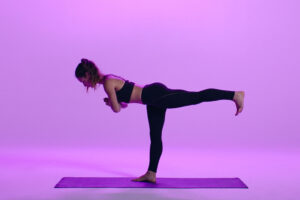
Exercises to enhance core balance and coordination are an essential component of any fitness routine. They help improve stability and agility and may reduce the risk of falling, especially as you age.
Start with simple exercises and gradually increase difficulty as your skills improve. Incorporate coordination drills, such as ladder drills and agility cone exercises into your workout.
Swiss Ball Hamstring Curl
The Swiss ball hamstring curl is a great exercise to strengthen the hamstrings and core. The exercise also challenges balance and coordination. It can be difficult for beginners to perform correctly. It is best to start with the double-leg version and once you have mastered multiple sets of 8 or 10 reps, you can try a single leg variant.
Begin by lying flat on the floor with your heels resting on a stability ball that is positioned about 2 feet away from you. Place your hands on the ground beside you to provide extra stability. Use your legs and core to lift your hips into a bridge position on the ball.
Once you have your bridge in position, bend your knees to roll the Swiss ball towards your feet, bringing your feet into an elevated glute bridge position. Then, roll the ball back to the starting position. Repeat the process with each leg. Aim to complete the set with good form and control.
Single Leg Lunge
“Leg day” is a scary two-word phrase for many gym bros, evoking visions of lower body-crushing heavy squats, deadlifts and leg presses. While these exercises are critical for building lower body muscle mass, they can also be boring and uninspiring. Try these single-leg variations to keep the workout fresh and challenge your balance and coordination.
Stand with your feet hip-width apart, contract the core and then step your right foot forward and lower into a basic lunge position. Then, twist your torso to the left while keeping the back knee at a 90-degree angle and in line with the ankle. Push through your right foot to return to the lunge and then repeat on the opposite side.
To progress this exercise, add a jump to the movement by driving through your right foot and powering the knee up to hip height before returning to the lunge. Be careful not to push your knee out too far, as this can compromise the health of the joint.
Trunk Rotation
Trunk rotation is a good core exercise to add to a workout program. It can also be used as a rehabilitation exercise for people with lower back problems. Adding trunk rotation to your routine can help reduce lumbar spine stiffness and improve posture, which helps with overall spinal stability and mobility.
To perform a trunk rotation, start by standing with your feet hip-width apart. Hold a medicine ball up by your chest and move your left arm out in front of you to rotate your torso. Hold the end position for a second and then return to the starting position. Repeat the move ten times on each side.
The difficulty level for this core exercise can vary, depending on how many of the core muscles you engage during the movement. If you’re not engaging your core muscles correctly, the exercise may feel painful in your low back. Aim to focus on the muscles that you’re working and gradually increase your intensity as you progress.
Plank With Leg Lift
Planks are one of the most popular core exercises around and the standard wall plank is an excellent exercise to improve your balance and coordination. To make it more challenging, try incorporating a leg lift into the movement. This can be done in place of the standard plank, or you can hold a weight in each hand or use a resistance band around your ankles to increase intensity and target the muscles more effectively.
Lie face-down on a mat and position your forearms directly beneath your shoulders. Brace your abdominals to keep the spine in a neutral position. Extend both legs behind you and raise the right leg until it is just above hip height, pause for a second or two before lowering it back to the floor. Repeat with the left leg.
This variation adds a dynamic movement to the basic wall plank, targeting the shoulder stabilizers and the muscles on the sides of your torso (the obliques). Perform for a set number of repetitions or time duration.